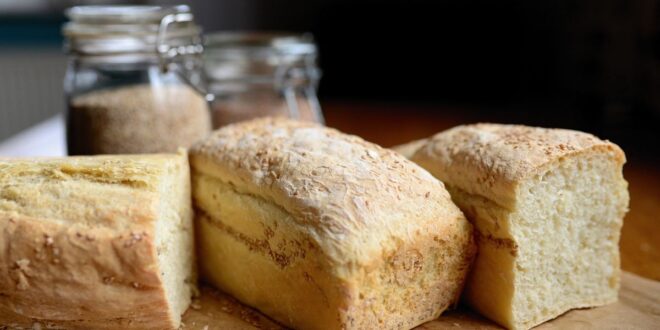Nothing beats the fresh and great smell and taste of freshly baked bread. However, keeping bread fresh is usually a losing battle, and it can go stale quickly once it loses its moisture. How to soften hard bread once it has gone stale?
You can soften hard bread in three ways. First, you use an oven. Second, use a microwave; last, you can use a few celery sticks. When combined with water, it helps restore water to the starches inside the bread, helping it become soft and supple again.
This post explores how you can soften hard bread. It starts by discussing why bread goes stale and the steps you can take to soften it.
Why Does Bread Go Stale?
Bread becomes stale due to retrogradation, where the starch inside the bread loses some moisture, causing it to become crystallized and hardened. As such stale bread tends to feel dry and hard as a brick. Fortunately, the process can be reversed temporarily.
We all know that you make bread by baking it in the oven, using a wet dough. Bread dough contains many elements, but in our case, we will only look at the starch.
When the baking process happens, the starches inside the bread are heated up with moist heat. This causes it to absorb moisture and water, resulting in the starch granule swelling. This explains why loaves of bread are extremely puffy when fresh from the oven.
When you take the bread loaf out of the oven, the starches start to cool, gelatinize, or thicken. This is the reason fresh bread is very spongy and springy.
However, over time, the starch gives back some of its water to the atmosphere, a process called retrogradation. In retrogradation, the moisture inside the bread slowly works its way up and into the air. The process may be more acute and faster if the surrounding air is dryer.
Once these starches lose moisture, they revert to their crystalline structure, causing the bread to become hard and brittle. Instead of tearing into spongy, springy bread, you now feel like you are tearing cardboard.
Many people discard their bread at this point, as to them, the bread is beyond saving. However, with the right knowledge, you can reverse the process, albeit temporarily.
There is still some moisture remaining in the starches, and you can always reintroduce some moist heat and entourage the starches to reabsorb it. This way, your bread will then revert back to its original state, springy, fresh, and tasty.
It doesn’t matter if your bread is sliced or in a loaf form. You can soften hard and stale bread with the right steps, whether they are sliced bread or a hard Batard.
How To Soften Hard Bread?
You have three ways to soften hard bread. You can use a microwave or an oven. With these methods, you reintroduce moist heat back into the dried starches. Another slower way is to keep the bread in a bag with celery sticks. The bread will slowly absorb the moisture from the celery and become soft as a process.
Fortunately, softening hard bread is not rocket science, nor do you need a lot of tools, gadgets, and ingredients. You only need some water, wrappers such as aluminum foil or paper, and celery sticks.
There are three popular ways to soften hard bread, which we will now look into one by one.
Option 1: Use An Oven
With this method, you essentially use heat to slowly reintroduce moisture into the bread. This method may work best on a bread loaf instead of bread slices.
Using the oven to soften your hard and stale bread will take a little longer than using the microwave, but it works just as well. It is a good option to consider if you do not have a microwave around.
To execute the oven method:
- Warm up your oven to 300°F (148°C approx) or the lowest temperature your oven can go.
- While the oven heats up, prepare your bread. Prepare a piece of aluminum foil. It should be large enough to cover your bread.
- Wrap your bread inside your bread loaf.
- If your bread is really hard and dry, dab some water onto the bread surface with your finger.
- Do not dab too excessively, as if you overdub water, you will end up with mushy bread on the outside. It doesn’t have to be a lot. You can always top up later.
- Place your foil-covered bread into the oven, and allow it to sit inside for 5-20 minutes.
- How long you let your bread stay inside depends on the size of your bread:
- If it is a small slice or a small roll, 5 minutes is often enough.
- Give the bread 10-15 minutes if it is a small loaf.
- If it is a larger load, allow 20 minutes in the oven.
- Remove the bread from the oven. Allow some time to rest. Do not open the aluminum foil, as you want the hot, moist air to remain around the bread. If you open it, the moisture will escape, including the ones you just reintroduced into your bread.
- Serve and enjoy once the bread is cool enough to the touch.
Option 2: Use A Microwave
Microwave is a godsend to humans, as it speeds up the warming and cooking of many things. It can also be used to heat up and soften your hard and stale bread. In fact, it is the fastest way!
The key is to understand that microwaves work differently than an oven. This means you do not want to use aluminum foil inside unless you enjoy seeing sparks flying around in your microwave and your bread becoming inedible. We will use wet paper towels instead.
To execute the microwave method:
- Take a fresh, clean paper towel. If the bread is large, you may need two towels.
- Soak the towels in cold water, then squeeze them out once they have absorbed the maximum amount of water.
- You should have a damp but intact paper towel.
- Wrap your paper towels around your bread loaf. When wrapping, try to ensure a snug fit, but not too tight until the towel tears.
- Place your towel-covered bread into the microwave.
- Run on high power for 10 seconds.
- Remove the bread from the microwave and the towel covering.
- The towel may be hot, and the bread may be full of hot steam, so be careful, so you do not scald yourself.
- Allow the bread to cool to the touch before serving.
Option 3: Celery Sticks
This method is the easiest since you do not even need to use a microwave or oven. All you need is a stick of celery stalk.
However, it takes time since you rely on the bread to slowly reabsorb moisture from the celery. Good results may need at least overnight, which means you may need to plan ahead and do this long before you eat.
Another thing about this technique is it may work well with sliced bread since it has more surface to absorb moisture. Loaf bread may not have much exposed surface, meaning it may be better to force in the moisture using an oven or microwave.
To execute the celery sticks method:
- Put your bread into an airtight container. It could be a food container, sandwich bag, or even your bread loaf bag.
- Slide a fresh celery stalk into the bag.
- Seal, or close off the container/bag.
- Place the bread, celery stick, and container/bag into the fridge, and let it sit for at least several hours. If you leave it overnight, you may get the best result.
- When ready, reopen the container/bag and observe the results.
- Usually, your bread will be softer and spongier, while your celery stalk will be fairly dry. This means the moisture has left the celery stick and absorbed into the bread.
- You may warm the bread normally with a microwave or enjoy the bread directly.
Can You Eat Hard, Stale Bread?
Hard and stale bread is usually safe to eat since it is the only bread that has lost its moisture. As long as there is no mold growth, it is safe to eat. However, it may not have a great taste or texture. It may also be very dry and hard to tear and bite into.
Sometimes, despite us knowing that we can actually soften hard, stale bread, we may still not have enough time to do that.
Say it is one of those morning rushes, and you want to have something in your stomach quickly. You may be tempted to just eat stale bread.
Fortunately, you can do that. Stale or hardened bread is simply bread that has lost its moisture in the starch. It is still safe to eat, most of the time. The key is to ensure the bread has no growths or mold.
You also want to ensure the bread does not taste weird, as it may be a sign of microorganism growth. If the bread tastes sour, it is probably spoiled.
However, stale bread may not taste as nice as fresh ones. They are dry, which means you may need to chew longer so that it absorbs your saliva and softens up. The sweetness of the bread may also not come until slightly later when the dried starch finally gets some moisture and reacts with your saliva.
How To Avoid Bread From Going Stale?
To avoid bread from going stale, choose bread with more fat, such as butter or eggs. Always allow the bread to cool to room temperature before freezing. If not freezing, consider keeping bread in airtight packaging or a container. Lastly, consume your bread as fast as possible while it is still fresh.
Prevention is always better than cure. You can assume the same applies to bread. There are several key points about keeping your bread fresher than longer or at least keeping it good enough to be easily warmed up again.
The key is to perform steps to help keep the moisture inside the bread for as long as possible:
Look For Bread With Fat
Ever wonder why bread such as Croissants does not go stale as quickly? It is because high-fat content actually helps to preserve the bread and slow down the process of it going stale.
As such, if you intend to keep your bread slightly longer than usual yet still want them fresh, consider buying bread that uses butter, eggs, or oil. Examples include Croissants, Brioche, or butter bread.
Cool Before Freezing
One of the best ways to keep bread fresh is to freeze it. The reason is when you freeze your bread, the moisture inside the scratch becomes frozen and stays inside the bread. When you thaw the bread, the moisture remains inside the bread, meaning it does not go stale.
However, before you freeze the bread, ensure it has cooled down to room temperature. This is because if it is still hot, the moisture may not completely settle inside the starch yet, meaning some may escape. Your bread may lose some moisture this way.
Keep In Airtight Packaging
If you do not intend to freeze your bread, keep them in airtight packaging. It could be an airtight food container or a bag. The idea is to keep the air surrounding the bread moist to slow the retrogradation process.
If you leave the bread in the open, the air may dry out the bread much quicker, resulting in the bread going stale much faster.
Consume When Fresh
This goes without saying if you want it fresh, eat it while it is fresh. Plus, nothing beats the taste of warm bread out of the oven or your favorite bakery.
How To Reuse Stale Bread?
To reuse stale bread, you can repurpose them into things such as breadcrumbs. You can use them as stuffing or as croutons. You can also serve stale bread with soup or use it in bread pudding. Finally, you can use stale bread for grilled sandwiches and dippers to replace chips and breadsticks.
Well, suppose your bread is really dry and is probably beyond saving. You do not need to throw it away because, technically, it is still safe to eat.
Fortunately, there are many ways you can repurpose stale bread and turn them into something nice to eat:
Breadcrumbs
Take your stale bread and bake them in the oven at 200°F (93°C approx). Take it out, and blend it using your blender. And now you have toasty, crunchy breadcrumbs. If you feel like it, throw in some spices and herbs.
Use it as breading for your fish and chips or as binders for your meatballs and burger patties. You can also use these breadcrumbs as toppings or mac and cheese for your casseroles.
Stuffing
This may be the most traditional way to use stale bread. Cut your stale bread up into cubes, and add it to your dishes. Add it to some sauteed veggies in a pan with some broth. Transfer the whole mix to a baking dish, and bake until it’s golden brown.
Croutons
Croutons are crunchy, making them perfect as a topping for salad or soup. Cut your stale bread into cubes, and toss it with olive oil, dried herbs, and garlic powder. Add this to your salads or any creamy soup for a great enjoyable meal.
Bread Pudding
Stale bread can be used to make great desserts, such as bread pudding. Cut the stale bread into cube form, and combine with fruit, milk, or spices such as cinnamon. Put into ramekins, and bake until it is thick and golden brown.
Grilled Sandwiches
You grill your sandwich bread to dry it out and make it crispy. Starting with a slice of stale bread will get crispier and crunchier bread since it is already dry. Slap on some of your favorite cheeses between slides of stale bread, grill it up, and enjoy!
Dippers
Who needs breadsticks of chips when you have stale bread? Simply cut the stale bread into long sticks so you can easily dip it into your favorite salsa, nachos, or hummus dips.
 Being Human
Being Human





